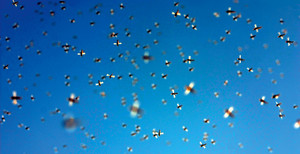
Wikimedia Commons
About 3.5 trillion insects cross the skies of the southern United Kingdom every yearWikimedia CommonsA mass movement of living creatures occurring at heights ranging from 120 meters to 1.2 kilometers above the heads of people in Britain goes practically unnoticed. These are clouds of small and large insects that, like migratory birds, regularly cross the southern United Kingdom with the changing seasons. Using radar measurements and samples collected by balloon, Chinese, Israeli, and British scientists have estimated that some 3.5 trillion insects flew over the southern United Kingdom each year from 2000 to 2009 (Science, December 23, 2016). This flow of airborne invertebrates amounts to the movement of 3,200 metric tons of biomass and includes insects like ladybug beetles, butterflies, moths, water boatmen, and hoverflies. In the fall, the insects fly south, where it is warmer, while they head north in the spring. Their path takes advantage of wind movements and they can travel at speeds of up to 58 kilometers per hour. During the period of observation, radar recorded 1,320 mass migrations of medium-sized and large insects in the daytime and 898 at night. “Insect bodies are rich in nutrients and the importance of these movements is underappreciated,” says biologist and study coordinator Jason Chapman of the Centre for Ecology and Conservation at the University of Exeter’s Penryn Campus in Cornwall, England. “If the densities observed over southern UK are extrapolated to the airspace above all continental landmasses, high-altitude insect migration represents the most important annual animal movement in ecosystems on land, comparable to the most significant oceanic migrations.”
Republish